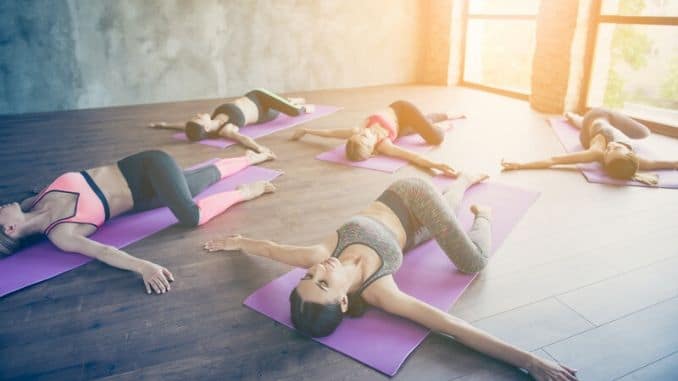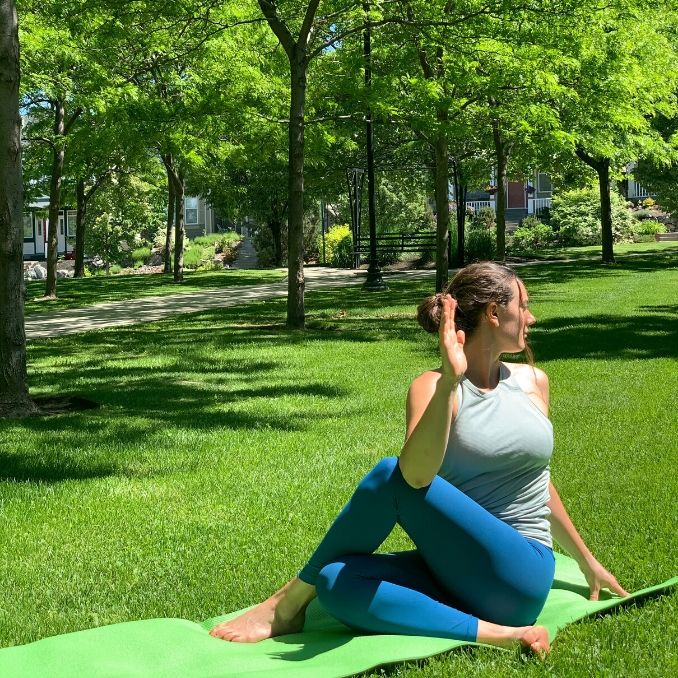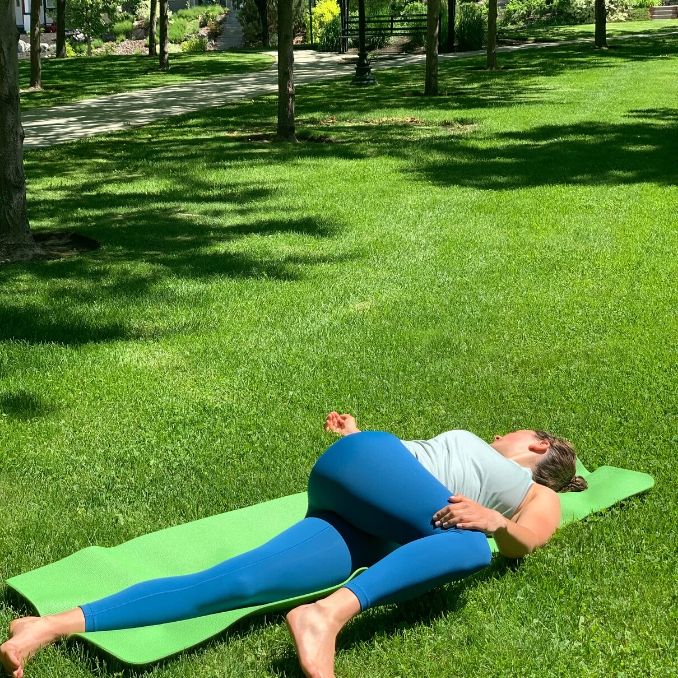
If you’ve ever taken a yoga class or followed one online, you’ve likely encountered Yoga Twists. These poses offer numerous health benefits by gently rotating the spine and releasing tension while stretching and opening the back muscles.
Twisting regularly ensures that we keep our intervertebral joints mobile and healthy. The soft tissue around your spine can also become stiff, causing pain and injury. Twists can help prevent this to keep us feeling our best.
When practicing Yoga Twists, we aim to lengthen our spines, creating space and relieving compression between the vertebrae. These twists actively engage the core, making them excellent for strengthening abdominal muscles. Additionally, Yoga Twists can enhance digestion by promoting the movement of food through the digestive tract, supporting overall gut health.
As always with yoga, let your breath and your body be your guide. If any pose does not feel right in your body or constricts your breathing, ease-out, and try a modification.
1. Seated Spinal Twist (Ardha Matsyendrasana)

This Yoga Twist involves full-body activation, providing a great strengthening effect for your core. Since you’ll likely incorporate this twist frequently in your practice, it’s essential to learn the basics of executing Yoga Twists safely and effectively. Mastering the right alignment and breathing techniques can help you avoid strain and make the most of this powerful pose.
- Start seated: Extend both legs in front of you.
- Bend right knee: Place your right foot close to your seat, or cross it over your left leg to plant it outside your left knee/thigh, keeping your foot firmly on the mat.
- Activate left foot: Flex your left toes back toward your shin.
- Position arms: Wrap your left arm around your right leg, or place your left elbow outside your right knee. Your right arm supports behind you like a kickstand.
- Lengthen spine: Inhale to sit tall, imagining a string pulling your head upward.
- Twist gently: Exhale to twist to the right, starting from the base of your spine and letting your neck follow last. Avoid forcing the twist.
- Synchronize breath: Use each inhale to lengthen and each exhale to deepen the twist. Allow subtle movement in and out of the pose with your breath.
- Repeat on the left side: Mirror the pose on the opposite side for balance.
- Hold this position for 5 to 10 breaths on each side.
Modifications: If you find it difficult to sit tall with your legs in front of your body, there are a couple of modifications for you to try. First, you can try the seated spinal twist variation detailed next in this article. Second, you can try placing a block or other support under your seat to create more space for your back body (pillow, folded blanket, etc.).
2. Seated Spinal Twist Variation (Ardha Matsyendrasana)

This twist is a variation of Ardha Matsyendrasana (the first twist in this list). This version will stretch the hips and may be more comfortable for some people.
- Begin seated and follow the steps from the previous pose.
- Instead of keeping the left leg straight, bend the left knee and bring the left foot toward the right hip.
- Wrap your left arm around your right knee if it feels more comfortable; this may also enhance the hip stretch.
- Repeat the stretch on the opposite side.
- Hold this position for 5 to 10 breaths on each side.
Modifications: If you find one hip comes up off the floor, support yourself by placing a block or other support under your seat.
3. Two Knee Spinal Twist (Jathara Parivartanasana)

This version of a supine spinal twist gives you the option of a more active or restorative posture. By actively pulling your knees toward your chest, you will work on strengthening your core, or you can relax the core for a gentler option.
- Lie on your back with your arms extended out to the sides.
- Use your core to draw your knees toward your chest.
- Slowly lower your knees to the right, allowing your torso to twist.
- If your knees don’t reach the ground or the stretch feels intense, place a support under or between them.
- Turn your gaze to the left for a deeper stretch, if comfortable for your neck.
- For an active variation, pull your knees closer to your chest or hover them just above the ground.
- Repeat the twist on the left side.
- Hold this position for 10 breaths on each side.
Modifications: For a gentler twist, begin with your feet mat-width apart before you drop your knees to the side. To intensify the twist, you can cross your top leg over your bottom leg, or use your hand to press your knees toward the ground.
4. Supine Spinal Twist (Supta Matsyendrasana)

I like to end most classes with Supta Matsyendrasana for its calming properties. The more you surrender into this pose, the more benefit you will get out of it.
- Lie on your back with your right knee bent and the sole of your foot flat on the mat.
- Shift your hips slightly to the right by pressing into your right foot (optional for a deeper twist).
- Bring your right leg over to the left side of your body, using your left hand to guide your knee toward the floor.
- Keep your shoulders grounded on the floor, if possible; it’s okay if they lift slightly.
- Position your arms in a “T” shape or keep your left hand pressing gently on your right knee.
- Use support such as a block under your right knee, if needed, for comfort.
- Repeat the twist on the left side.
- Hold this position for 10 breaths on each side.
Modifications: For more support in this pose, place a bolster, pillow or rolled-up blanket behind your back.
Twists are an amazing way to keep your spine healthy and mobile, while also relaxing the nervous system. I hope you try out these poses and enjoy them as much as I do.
Thank you for joining me!
Namaste,
Kiah, RYT 200
With so much time spent in front of a computer or cell phone, forward head posture has become far too common. Check out Forward Head Posture Fix, here!

